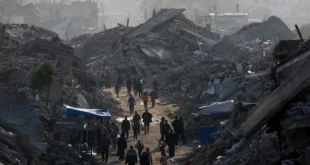Azerbaijan has agreed to extend a deadline for Armenia to withdrawal from a district as part of a peace agreement that ended a six-week war over the breakaway Nagorno-Karabakh region.
“Azerbaijan agreed to prolong the deadline for the withdrawal from Kalbacar of Armenian armed forces and of illegal Armenian settlers until November 25,” Hikmat Hajiyev, an aide to Azerbaijani President Ilham Aliyev, told a news conference in Baku on November 15.
He said Aliyev had agreed on “humanitarian grounds” to grant an Armenian request for the delay following mediation by Russian President Vladimir Putin.
Armenia was due to complete its withdrawal from Kalbacar (known as Karvachar in Armenian) on November 15.
Hajiyev said the timetable for the Armenian withdrawal from the Aghdam region on November 20 and the Lachin district by December 1 remains unchanged.
Residents of Kalbacar, a district in Azerbaijan that was controlled for decades by ethnic Armenians, have been leaving their homes since the peace deal was signed on November 10.
Some residents set their homes on fire before leaving, RFE/RL’s Armenian Service reported.
Kalbacar was populated mostly by ethnic Azeris before they were expelled by Armenians in the 1990s war following the breakup of the Soviet Union, and a majority of the homes being abandoned previously belonged to Azeris.
Before it was ceded to Azerbaijan, Armenians flocked to the Dadivank monastery for a final visit. Russian peacekeepers were positioned near the monastery on November 14.
The Kremlin said that Putin told Aliyev on November 14 to protect Christian shrines in the parts of Nagorno-Karabakh that will be under the control of Azerbaijan, a majority Muslim nation.
Aliyev vowed to safeguard the Christian shrines, a statement released by his press service said.
A key part of the Russia-brokered peace deal includes Armenia’s return of Kalbacar and two other districts over the next 2 1/2 weeks. Like Kalbacar, those districts have been held by Armenian separatists since a war that ended in 1994.
While ending fighting that killed up to 5,000 soldiers and civilians on both sides, the deal announced on November 10 was rejected by many Armenians because it allows Azerbaijan to keep a sizable chunk of Nagorno-Karabakh, along with surrounding areas captured during the fighting.
The deal includes the deployment of 2,000 Russian peacekeepers in the region. Several hundreds have already arrived since the announcement of the truce, and Russia’s Defense Ministry said on November 15 that they had set up 25 “observation posts” in the Lachin Corridor — a mountain road pass that links Nagorno-Karabakh to Armenia — and two other areas to monitor the cease-fire.
The two sides exchanged the bodies of an unspecified number of dead soldiers on November 14 following the arrival of the Russian troops.
Nagorno-Karabakh is recognized as part of Azerbaijan, but its majority Armenian population has governed its own affairs since Azerbaijani troops and Azeri civilians were pushed out of the region in the war in the 1990s.
Armenia’s Health Ministry said on November 14 that at least 2,300 Armenian and Nagorno-Karabakh Armenian combatants have died during the most recent fighting, which broke out in late September. A ministry spokeswoman, Alina Nikoghosian, said the figure does not include dead soldiers whose bodies remain in Azerbaijani-controlled territory. Their total number is not yet known, she said.
Azerbaijani authorities have not released their military casualty figures.
The announcement of the peace deal triggered celebrations in Azerbaijan and a political crisis in Armenia, where angry protesters stormed government buildings and parliament.
On November 11, 10 prominent opposition figures were arrested and accused of “organizing illegal violent mass disorder.” The detentions were denounced by the opposition as illegal, and the opposition figures were released two days later.
The leader of Armenia’s opposition Homeland party, Arthur Vanetsian, was arrested on November 14 and accused of plotting to overthrow the government and of an assassination plot against Prime Minister Nikol Pashinian.
Vanetsian, who formerly headed Armenia’s National Security Service (NSS), was arrested after his arrival at the service’s Investigative Department on November 14, according to his lawyer.
“Vanetsian was arrested on suspicion of usurping power and preparing the assassination of Prime Minister Nikol Pashinian,” attorney Lusine Sahakian wrote on Facebook.
In addition, Sahakian wrote, “illegal searches” were carried out in Vanetsian’s parents’ apartment and an office affiliated with the Homeland party.
Both Sahakian and Vanetsian’s Homeland party condemned the move as politically motivated.
The NSS has not confirmed Vanetsian’s arrest, but in a November 14 statement it said that it had thwarted an assassination attempt against Pashinian.
Homeland is one of 17 Armenian opposition groups that launched the protests and demanded Pashinian’s resignation. They accuse Pashinian of capitulating to Azerbaijan and committing high treason.
 Eurasia Press & News
Eurasia Press & News



